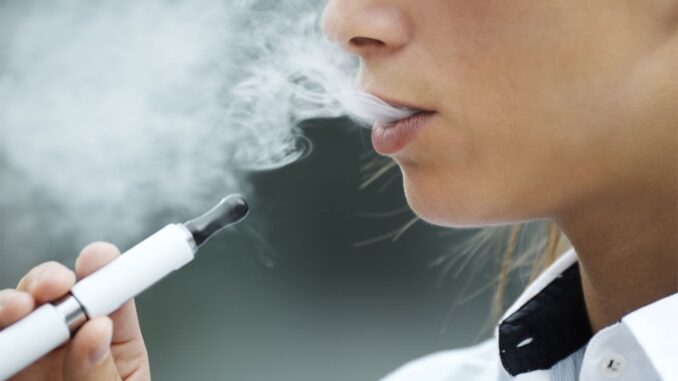
Vaping is a controversial topic in any school. Students, manufacturers, teachers, parents, and law-enforcement all have their own motives and interests. As with any recreational substance, the facts are muddied by every contrasting bias. Taking an objective look at vape usage, we can more accurately assess risk and promote harm reduction.
A vape is an electronic device used to diffuse a concentrated liquid solution of some type of recreational drug, typically nicotine or cannabis. For this article’s purposes, we will be focusing on nicotine use, as it is the most prevalent among high schoolers. Vape liquid comes in many different flavors; for example, banana, mint, berry, bubblegum, and cinnamon. There’s also a variety in the strength of each liquid.
Vapes entered the market around 2003 and have become extremely popular over the years, especially with teenagers and young adults. In 2011, there were 7 million vape users. In 2021, that number rose to 82 million. Vape usage has increased exponentially in teens. According to the CDC, one in five American teens have vaped before; 22.5% use daily.
Schools and anti-tobacco campaigns alike have been quick to take notice and action, leading to new policies and campaigns. One of the more well-known of these is the TRUTH campaign, originally known as the Florida Tobacco Pilot Program, a campaign that seeks to end vaping among gen Z.
While there is nothing inherently wrong with trying to prevent drug use among teenagers, the TRUTH campaign tends to err on the side of prohibition of all recreational drug use. Prohibition policies cause hundreds of thousands of deaths a year and are responsible for drug use being as dangerous as it is. For example, TRUTH often makes the claim that vaping is no safer than smoking. This is, firstly, false, and secondly, hurts more than it helps. A teenager who vapes isn’t going to stop vaping because they saw an ad, but they might start smoking if they think it’s no worse.
This harm also comes in the form of legal consequences. While Inland Lakes doesn’t take legal action if a student is caught vaping, many other schools do. The school-to-prison pipeline is something too complex to get into in this article, but it can be summarized as the fact that sending teenagers to prison, among other penal actions, (unsurprisingly) makes the problem worse. Giving someone a criminal record rarely cures their addiction, nor does it address the problems, both personal and structural, that lead to teen drug use.
All of this misinformation and fear obscures the actual truth about vaping, or what it actually is to begin with. Why do people vape, anyways?
To start, the strongest psychoactive (affecting the mind) chemical in both tobacco and e-liquid is nicotine. This is why it’s possible for electronic cigarettes, nicotine gum, etc. to exist- because it isn’t every chemical in tobacco that produces the effect. So, what does nicotine actually do?
Nicotine, classified as a stimulant, is a proven performance enhancer. Multiple studies have shown improvements in motor abilities, alertness, attention, and memory. But as a recreational experience, many users report more negative than positive effects. One user reporting his experience on the website erowid stated, “The feeling is very much like caffeine side effects with none of the mental stimulation. Jittery feeling, mild nausea, but I noticed no mental effects at all.”
Although safer than traditional cigarettes, vaping still carries many health risks and has some of the worst addiction potential of any drug. While cytotoxicity (harmfulness to cells) varies between different liquids, adverse effects include chest pain, nose bleeds, airway inflammation, nausea, coughing, and headaches. There is also evidence to suggest that vaping harms neurons and triggers spasms, but this is not conclusive.
Nicotine is considered one of the most addictive drugs in existence, as addictive as heroin and cocaine. First time nicotine users become dependent 32% of the time. Nicotine is both mentally and physically addictive. Withdrawal symptoms include extreme cravings, irritation, anxiety, lack of focus, insomnia, and depression, and typically last weeks or a month. Less than 1/10th of people who try to quit nicotine succeed.
Another issue is the prevalence of contaminants in e-liquid. Many carbonyl compounds (which are often toxic to humans in high doses) can form when the e-liquid is heated, depending on the composition of the liquid itself and the voltage of the pen. Reduced voltage (3.0 V) has a lower risk of carbonyl formation, while high voltage (5.0 V) can produce as much or more than tobacco.
Even when using a safe voltage, there’s a risk of contaminants. Researchers at John Hopkins University found over 2000 unknown chemicals in vape clouds from a variety of manufacturers. Vape clouds are known to create particles of toxicants, carcinogens, and heavy metals, which are dangerous to human health. The amount and concentration varied across and within manufacturers and liquids.
It is also dangerous to modify the device itself. In 2018, a Florida man was killed when his vape exploded, which sent the pen through his skull. Modifying a vape pen risks putting more stress on the lithium ion battery than it can handle, which is what caused the explosion.
Overall, while response to teen nicotine usage may be excessive, it is important to remember that nicotine is still a drug with a high risk for harm. It is not advisable to use nicotine, especially if underage. But if you do, research the health risks of the individual liquid BEFORE you smoke it, buy from safer liquid vendors, smoke at a low voltage, don’t modify your pen, and take tolerance breaks to prevent addiction.
